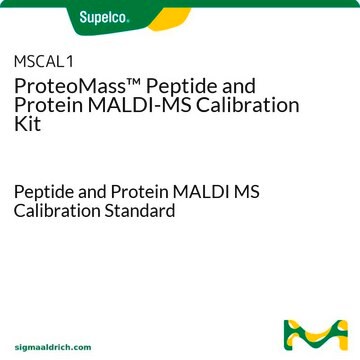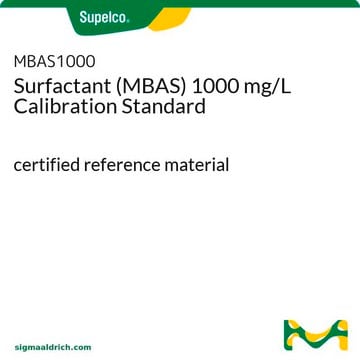MSCAL5
ProteoMass™ LTQ/FT-Hybrid ESI Pos. Mode Cal Mix
Sign Into View Organizational & Contract Pricing
All Photos(1)
About This Item
UNSPSC Code:
41116107
NACRES:
NA.24
Recommended Products
product line
ProteoMass™
CofA
current certificate can be downloaded
packaging
pkg of 1 × 10 mL
storage condition
protect from light
concentration
(varied conc.)
technique(s)
mass spectrometry (MS): suitable
format
multi-component solution
shipped in
dry ice
storage temp.
−20°C
Looking for similar products? Visit Product Comparison Guide
General description
The ProteoMass ESI Calibration Kit for LTQ based Hybrids, positive ion mode calibration solution, enables calibration of Thermo Scientific hybrid instruments equipped with ESI source in positive ion mode. It covers a mass range from m/z 138 to m/z 1822, and is therefore usable for calibrations between m/z 50 and 2000.
Application
ProteoMass™ LTQ/FT-hybrid ESI Pos. mode cal mix has been used as a calibration standard for the mass spectrometric analysis of serum samples of patients affected by mugwort pollen allergy induced by pollen extract of Artemisia vulgaris.
Features and Benefits
Discover the Advantages for Yourself!
- Ready-to-use
- Developed and qualified specifically for use with the LTQ based Thermo Scientific hybrid instruments (LTQ FT, LTQ FT Ultra, and LTQ Orbitrap series) with ESI source and Thermo Scientific Exactive
- Conveniently packaged, freeing you from time consuming mixing and dilution steps, allowing you to focus on the acquistion of quality data
Legal Information
6538 is a trademark of American Type Culture Collection
ProteoMass is a trademark of Sigma-Aldrich Co. LLC
Signal Word
Danger
Hazard Statements
Precautionary Statements
Hazard Classifications
Acute Tox. 3 Dermal - Acute Tox. 3 Inhalation - Eye Irrit. 2 - Flam. Liq. 2 - STOT SE 1
Target Organs
Eyes,Central nervous system
Storage Class Code
3 - Flammable liquids
WGK
WGK 2
Flash Point(F)
42.1 °F - closed cup
Flash Point(C)
5.6 °C - closed cup
Choose from one of the most recent versions:
Already Own This Product?
Find documentation for the products that you have recently purchased in the Document Library.
Customers Also Viewed
Hypoallergenic acid-sensitive modification preserves major mugwort allergen fold and delivers full repertoire of MHC class II-binding peptides during endolysosomal degradation
Stanic-Vucinic D, et al.
Royal Society of Chemistry Advances, 91(6), 88216-88228 (2016)
Adam P Bateman et al.
Analytical chemistry, 82(19), 8010-8016 (2010-09-03)
This work demonstrates the utility of a particle-into-liquid sampler (PILS), a technique traditionally used for identification of inorganic ions present in ambient or laboratory aerosols, for the analysis of water-soluble organic aerosol (OA) using high-resolution electrospray ionization mass spectrometry (HR-ESI-MS).
Juan Chavez et al.
Chemical research in toxicology, 23(1), 37-47 (2010-01-02)
The protein targets and sites of modification by 4-hydroxy-2(E)-nonenal (HNE) in human monocytic THP-1 cells after exogenous exposure to HNE were examined using a multipronged proteomic approach involving electrophoretic, immunoblotting, and mass spectrometric methods. Immunoblot analysis using monoclonal anti-HNE antibodies
Jérôme Laparre et al.
Analytica chimica acta, 951, 99-107 (2016-12-22)
Urine stability during storage is essential in metabolomics to avoid misleading conclusions or erroneous interpretations. Facing the lack of comprehensive studies on urine metabolome stability, the present work performed a follow-up of potential modifications in urinary chemical profile using LC-HRMS
Adam P Bateman et al.
Physical chemistry chemical physics : PCCP, 13(26), 12199-12212 (2011-05-28)
The effect of UV irradiation on the molecular composition of aqueous extracts of secondary organic aerosol (SOA) was investigated. SOA was prepared by the dark reaction of ozone and d-limonene at 0.05-1 ppm precursor concentrations and collected with a particle-into-liquid
Our team of scientists has experience in all areas of research including Life Science, Material Science, Chemical Synthesis, Chromatography, Analytical and many others.
Contact Technical Service








![[Glu1]-Fibrinopeptide B human ≥90% (HPLC)](/deepweb/assets/sigmaaldrich/product/structures/122/537/7ead5c32-cb67-4325-9ce7-66c8dec24bdd/640/7ead5c32-cb67-4325-9ce7-66c8dec24bdd.png)





